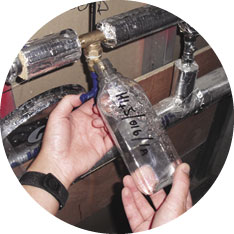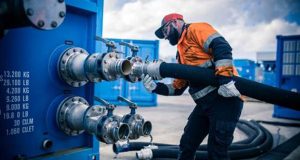The LCA requires its members to have in place management procedures and appropriately competent staff, that give them the capability of responding appropriately to positive legionella results. Positive legionella results following sampling are one area where it’s possible to misinterpret the meaning and end up with what could at best be inappropriate expense and at worst, a dangerous situation and risk to life.
SAMPLE PLANNING
Interpretation of results starts with a suitable sample plan. Samples can be taken pre or post flush and with or without disinfection of the outlet. The selection of location, type of sample and method of analysis chosen forms part of the sample plan.
The first priority should be to consider measures to eliminate or reduce the risk before designing monitoring measures. Where it is impossible or not reasonably practicable to reduce the risk and the risk assessment recommends monitoring for the presence of legionella by sampling, there are a number of factors to consider in a sample plan; including:
 How often should samples be taken?
How often should samples be taken?
- Legionella is relatively slow growing but may develop to hazardous levels within days or weeks in ideal conditions
- The HSE guidance in HSG274 Part 2 details weekly samples for legionella where controls, such as temperature or biocide, are not being consistently achieved
Where should samples be taken?
- Samples should be checking areas where legionella is likely to grow – deadlegs, underused outlets, areas where controls have failed or areas where risk is identified for some other reason
How should samples be taken?
- For systems otherwise under control this method should generally be pre-flush without disinfection to examine the risk that exists to the users of the system from the outlets
- In some cases, it would also be appropriate to sample post-flush, with disinfection of the outlet to examine how the system is performing as a whole
- There is limited value in sampling post-flush downstream of mixing valves or sampling post-flush without disinfecting the outlet although sometimes this is useful in investigation work
CONFIRMING A POSITIVE RESULT
Positive legionella results occur in around 10–20 per cent of laboratory water samples, which take 10 days to complete and may take a further two days to confirm with traditional confirmation techniques. The laboratory will normally send a positive notification once the result is confirmed.
The LCA would expect that any registered member would have a procedure to notify their client, log the result, track actions, note resolution and close out a positive legionella result.
The result should be notified to a client at the earliest opportunity, and this includes interim positive results. HTM0401 Part B gives good advice on how to interpret positive legionella results in healthcare settings. For other settings the general principles are the same, but the susceptibility of the population is likely to be lower.
The interpretation of sample results will follow directly from a well-designed sample plan. A sample is a small part designed to represent a larger population. In this case you’ve selected small volumes of water to represent the risk in the water system as a whole. When addressing issues, you must consider the whole system and not just the sample locations if the results indicate widespread contamination.
CLIENT INFORMATION
An LCA Member’s procedure should detail how they tell their client the information and how they arrive at the advice they give. This procedure should then be followed in practice and at audit the LCA will expect to see an audit trail for each positive result.
For legionella to grow there must be suitable conditions and there will be a root cause for these conditions. Actions following positive samples must address the root cause rather than just the symptom. Common factors include:
- Stagnation, areas being less used than previously thought
- Thermal gain/loss, meaning systems normally reside at growth temperature despite running below 20 degrees after two minutes or above 50 degrees within one minute
- Stagnation due to failed HWS circulation
- Unknown deadlegs
- Materials or contamination in the system that support growth
Reviewing the assessment of the risk and addressing whatever is found must be the primary recommendation but unless very simple and straightforward to achieve, there should also be interim recommendations.
Recommended actions should be appropriate for the results. This can be a difficult balance to strike but if the results indicate limited localised issues, take limited localised action, if results indicate more widespread issues, take system level actions.
LOGGING A POSITIVE LEGIONELLA RESULT
The result should be logged on systems as a non-conformance like any other loss of control non-conformance. Your interpretation, recommended actions and the reasons behind these should also be logged and recorded as part of the process.
TRACKING A POSITIVE RESULT
Once the result has been logged in a system the consequent actions need to be tracked and auditable. If actions are required by you or your customer then ensure these are completed and recorded in your logging process.
RESOLVE THE POSITIVE RESULT AND CLOSE OUT
Once the root cause has been identified and resolved this action should be noted on a LCA’s member’s log and the positive result closed out. In many cases it is normal to carry out follow up sampling after remedial action to verify success.
SUMMARY
 Sampling for legionella can be an important part of the monitoring of control measures in a written scheme and competent interpretation of positive results is essential. Appropriate planning, technique and interpretation is vital to ensure the information obtained by sampling is valid and useful. The LCA requires members to have in place management procedures that detail how samples are planned, carried out, non-conformances logged and dealt with and actions closed out including communication with their clients.
Sampling for legionella can be an important part of the monitoring of control measures in a written scheme and competent interpretation of positive results is essential. Appropriate planning, technique and interpretation is vital to ensure the information obtained by sampling is valid and useful. The LCA requires members to have in place management procedures that detail how samples are planned, carried out, non-conformances logged and dealt with and actions closed out including communication with their clients.




